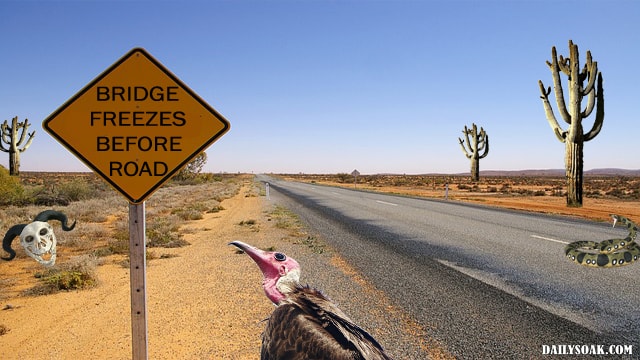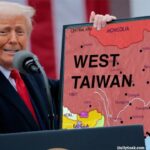CULVER CITY, CALIFORNIA– A traffic sign enthusiast has put out a new book recently about the history of traffic signs both past and present. The book includes hundreds of photos of road signs, including many that were only used for a short length of time due to either being completely useless, ineffective, or too offensive to certain groups of people.
Traffic signs are as ubiquitous and popular as mayonnaise on a peanut butter and horseradish sandwich. While some people merely admire traffic signs while out on the road, many fans go a step further and either collect them, worship them, or even write books about them.
In this article we’ll look at seven of the numerous traffic signs that are no longer in use and have become major collector’s items bringing in lots of money.
7. Squirrel Crossing Sign
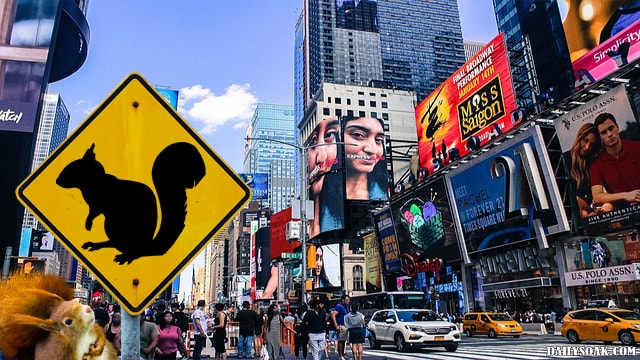
The Squirrel Crossing sign was created during the 1990’s Squirrel Lovers Movement. Due to an inordinate amount of squirrel deaths in the New York area, squirrel rights groups petitioned their local governments and got these signs plastered all over the busy city streets of New York.
After having these signs up for only two weeks, they were taken down due to a 500% increase in traffic collisions and fatalities. Government officials deliberated for many days on whether squirrel lives were more important than human ones. By a vote of 51 to 49, the signs were removed and drivers were free to once again run over the rodents with impunity.
6. The Capitulate Yield Sign
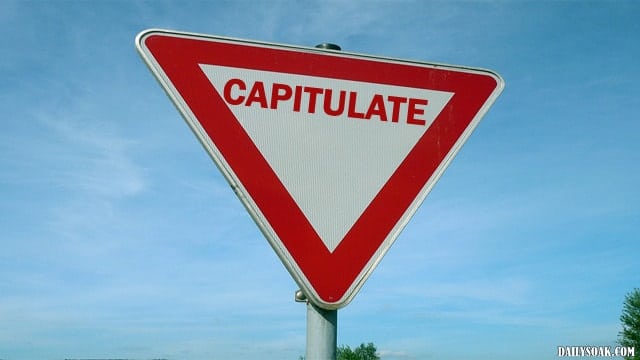
Hopefully most drivers know and recognize the current Yield Sign and what it stands for. But for a short period of time in 1984, the Yield Sign was known as the Capitulate Sign. A former California politician named Hans Schwanzenbacher came up with the ingenious idea of renaming all well-known street signs with lesser known and more complicated words.
Schwanzenbacher ran on a campaign that promised to teach citizens new and more complicated words in an effort to boost their vocabulary and hopefully make them smarter. He also changed many other standard traffic sign names such as changing the Stop Sign to the Cease Sign and the Speed Limit sign to the Speed Circumscription sign. Although Schwanzenbacher may have had good intentions, his plan ultimately caused more problems than it solved.
5. The Go Fast Pedestrian Crossing Sign
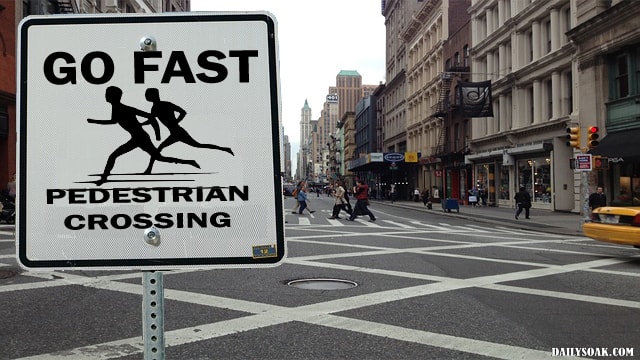
Around 1989, government officials in many big cities around the nation had the bright idea of requiring vehicles to actually go faster, not slower, at pedestrian crosswalks. The idea was that perhaps it would be safer for vehicles to hurry up and get out of pedestrians way, rather than going slower to avoid hitting people.
In only two days, 1,887 pedestrians were killed across the country thanks to the new Go Fast Pedestrian Crossing Signs. Even though some officials claimed that the new Go Fast signs actually helped keep pedestrians more alert, most voted in favor of going back to the Go Slow signs.
4. The Braille Stop Sign
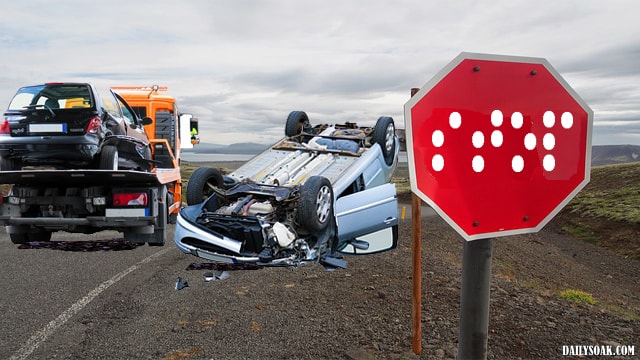
Back in the 1970’s, there was an odd influx of people who started going blind across the country. Officials had no answers for this phenomenon. So, instead of trying to figure out why hundreds of thousands of people started going blind, government officials instead opted to make traffic signs in braille for all those people who had lost their sight but refused to quit driving.
At first, the braille Stop Signs seemed to be working. But after the first five minutes of installing all the braille Stop Signs, traffic collision numbers started piling up more than normal sighted driver accidents in the Soviet Union. Those numbers also include drivers with sight who couldn’t read braille and didn’t know what the big red signs meant.
[adace-ad id=”17241″]
3. Bridge Freezes Before Road In Desert
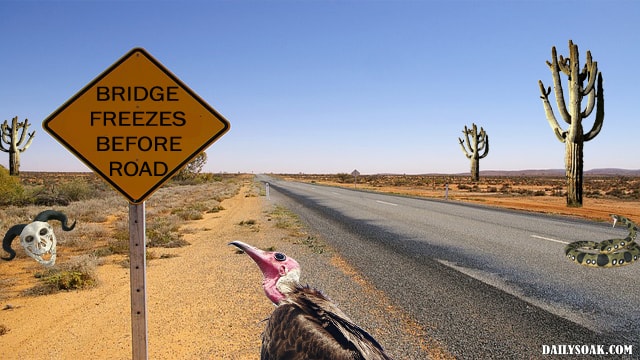
The 1960’s were a fun time. Not only did it give us the Beatles, but it also gave us the ubiquitous Bridge Freezes Before Road sign. What many people don’t know is that the very first Bridge Freezes Before Road Sign was actually placed in the middle of the Mojave Desert.
The idea for the sign came after a powerful 1960’s politician/hippie named Orion Peace Leaf had a dream where he was wandering through the desert and a naked American Indian told him that one day the desert will become cold and also require bridges for all the melted snow. Even though no one other than Peace Leaf ever took the sign seriously, the government allowed him to put the sign in the desert where it still stands today.
2. Speed Trap Ahead Sign
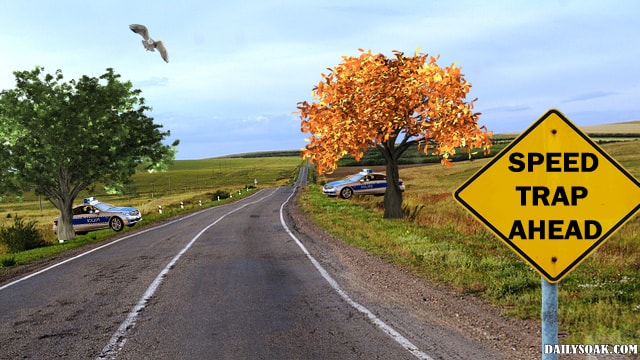
Most people probably hate speed traps, but what most people don’t know is that Speed Trap Ahead Signs actually existed for a short time in the 1980’s and were put there by the police departments themselves by order of politicians.
The Police Officer’s Organization came up with the idea of actually letting drivers know ahead of time that there was a police speed trap ahead. Law enforcement’s thinking was that, because most drivers disobey traffic signs anyway, that they would probably ignore the Speed Trap Ahead signs also, which would increase revenue for the respective cities through massive tickets. Unfortunately the reverse psychology didn’t work and police were forced to abandon the idea.
1. Female Drivers Keep Right Sign

Believe it or not, the Female Drivers Keep Right Sign didn’t originate back in the 1940’s, but was created in the 2000’s. Even though the sign was eventually taken down for obvious reasons, the push for the controversial signs was technically spearheaded by a group of female politicians, with the blessings of many anti-women groups.
The female politicians who came up with the idea for the signs claimed that the signs were meant to empower women, not discriminate against them. They said that female drivers shouldn’t have to share the same lanes with male drivers because male drivers are more prone to accidents.
The Female Drivers Keep Right Signs were eventually taken down, not because they discriminated against women, but because more and more groups started complaining that it wasn’t fair that women get to have their own lanes. Every group eventually wanted to be separated. But because there’s more groups of people than lanes on a highway, government officials banned the signs.




